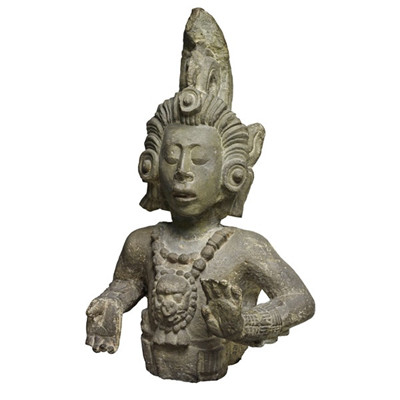The answer lies not in maize's divine connections, but in the environment that Central America offered. In this part of the world at this time around nine thousand years ago, other food resources were very thin on the ground. There were no easily domesticated animals-as you would find pigs, sheep or cattle elsewhere-and the staples were a trinity of plants that were slowly cultivated and tamed: squashes, beans and maize. But beans and squashes don't become gods -why does maize?
答案卻不是因為玉米本身有何神圣性,而是由中美洲自身的環境所決定的。九千年以前,在地球的這部分地區,其他食物來源相當之貧乏。也沒有容易馴化的動物。你在其他地區可以找到的豬、羊、牛之類的,這里都沒有。當時這里人類的主食主要有三種:瓜類、豆類及玉米。那為什么豆類與瓜類都成不了神,唯獨玉米可以呢?
Well, the plant from which maize derives, the teosinte, is wonderfully adaptable. It's able to grow in both the lush wet lowlands and the dry mountainous regions, which means that farmers can plant crops in any of their seasonal dwellings. On top of that, constant harvesting of the grain encourages the plants to grow larger and more abundantly, so maize quickly became plentiful-farmers got a healthy return for investing their labour. But crucially, maize is a rich carbohydrate that gives you a rapid energy hit. But it is, let's face it, pretty stodgy, and so from very early on, farmers also cultivated an ingenious-and tasty-accompaniment; the indigenous chilli. It has virtually no nutritional value but, as we all know, it's uniquely able to liven up dull carbohydrates-and it shows that we've been foodies for as long as we've been farmers.
其實那種玉米進化而來的植物大芻草具有很奇妙的適應性。它既能夠輕輕松松生長在郁郁蔥蔥的低海拔濕地,也能毫不費力地適應干旱少雨的山區,這樣農民就可以在任何季節任何地點種植這種植物。最重要的是,這種植物越是頻繁收割,或是可以結出更豐碩更充足的果實。因此玉米迅速成為廣受歡迎的農作物,家書辛苦付出的汗水總能有豐富的回報。另外關鍵一點是,玉米是一種營養豐富的碳水化合物,能夠迅速地補充人體的能量損失。當然,我們現實點來說吧,玉米吃起來味道真不咋的。很早很早以前,農民就巧妙地培育出了一種美味的調味品—土著辣椒。這種辣椒本身沒任何營養價值,但它恰恰能給食之無味的玉米變得好吃起來。這表明,自從我們人類學會了農耕,我們就學會當美食家了。
By AD 1000, maize had spread north and south, virtually through the whole length of the Americas; which is perhaps surprising-because, in its earliest form, not only did maize have little taste, it was practically inedible. It couldn't just be boiled and eaten straight away as it is today. Nine thousand years ago, the maize cob was very hard, and eating it raw would have made you very ill. It needed to be cooked in a mixture of water and white lime.
大概公元前1000左右,玉米已經由南到北,幾乎遍布了整個美洲大陸了。這可能會讓令人驚奇,因為其實最早期的玉米品種,不單單食之無味,而且根本就幾乎不能食用的。不像今天的玉米,可以直接煮來吃。九千年前,玉米芯是很硬很硬的,啃不下嘴;生吃的話你又會病得很慘。它必須在水與白石灰中煮熟。用這沸騰的石灰水來處理早期玉米芯絕對是必不可少的過程。
This elaborate process of boiling the raw kernel in lime and water was essential. Without it, the two key nutrients in the vegetable-the amino acids and vitamin B-would not be released. After all that, it had to be ground into a paste and then made into an unleavened dough. The god of maize expected his disciples to work hard for their supper. Even today, maize still dominates much of Mexican cuisine, and it still carries a surprisingly powerful religious and metaphorical charge, as restaurateur Santiago Calva knows only too well:
沒這樣做,玉米中最關鍵的兩種營養成份氨基酸和維生素B基本就釋放不了。接著,它還要被研磨成糊狀,然后再做成一種不發酵的面團。直到今天,玉米仍然在墨西哥菜系中占有主導地們,而且它本身仍然具備有一種令人驚嘆的強大宗教與象征性的蘊意。開餐廳的圣地亞哥?卡爾瓦再清楚不過了:
The continuous spin-offs of maize into daily life is vast and complex. At some stage there will always be maize around, and it jumps any class barrier or identity. Everybody eats it and drinks it, from the richest to the poorest, from the most indigenous to the least indigenous, and that's one thing that unites more than anything else.
“不斷由玉米衍生而來的事物,輕松隨意地滲透進人們的日常生活,影響即普遍又復雜。在某些階段,我們生活周遭永遠都有玉米的存在,超過了任何障礙與身份識別。從首富到最窮的,從最土著的到最不像土著的,大家吃玉米、喝玉米汁。玉米是一種比任何事物都要強有力的共同紐帶。”












